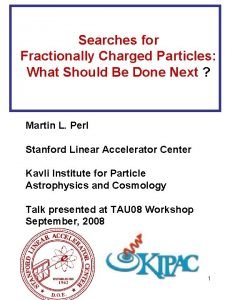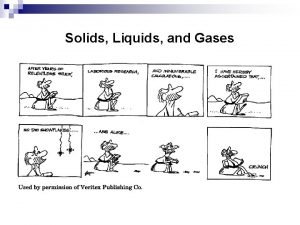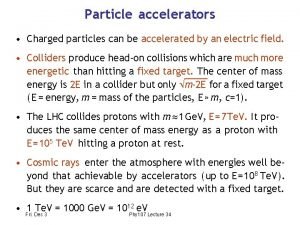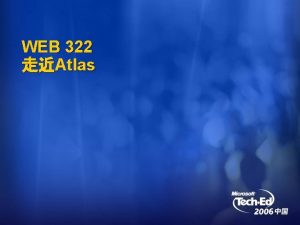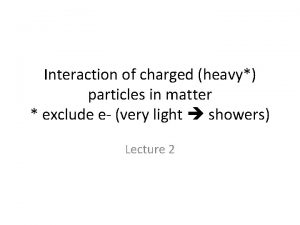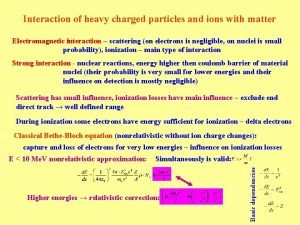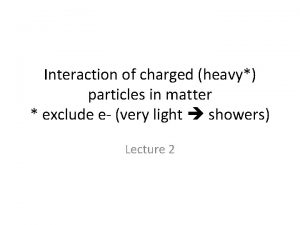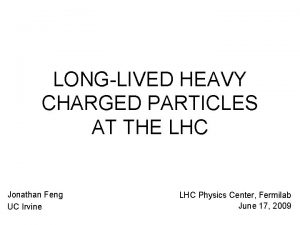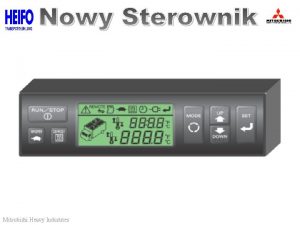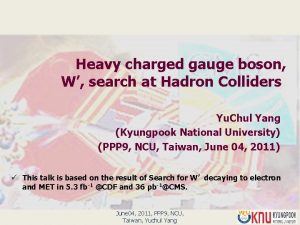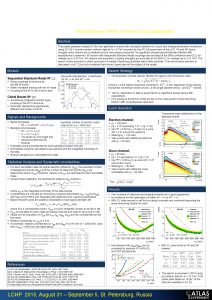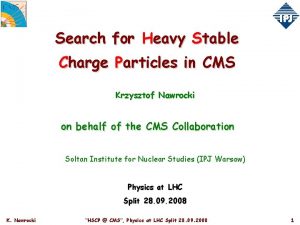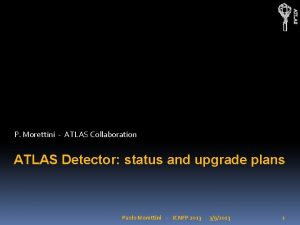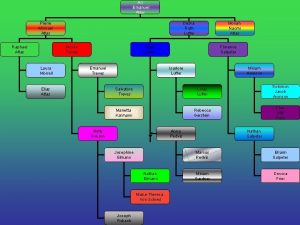Search for charged heavy particles in the ATLAS


















- Slides: 18

Search for charged heavy particles in the ATLAS detector C. Gemme 1, G. Gagliardi 1, E. Guido 1, A. Haas 2, S. Mehlhase 3, S. Passaggio 1, L. Rossi 1, C. Schiavi 1 1 INFN Genova, 2 SLAC, 3 Niels Bohr Institute Copenhagen LLP workshop, Rome Tor Vergata, 3 -4 December 2013 Outline: ü The Pixel d. E/dx ü 2011 dataset analysis ü On-going 2012 analysis ü Run 2 perspectives 1

Motivations for the searches with d. E/dx ü The ATLAS Pixel detector is able to measure the particle ionization in the very first cm of the trajectory. • This is not the case for CMS. ü and to tag identify tracks that do not behave as MIPs • High release due to low bg particles • Low release due to fractional charge particles ü Track d. E/dx is defined as the average of the 3 or more pixel clusters d. E/dx, having rejected the one with the highest ionization. • Resolution ~ 12% 2

Motivations for the searches with d. E/dx ü Bethe-Bloch empirical fit of low mass particles allows to measure the particle mass from its energy release and momentum measurement ü 5 -parameters function to describe the most probable value dependence on β: Proton mass • This calibration done in 2010 is very stable over the time. ü Used to search for charged massive particles. 3

Theoretical motivations ü Stable Massive Particles (SMPs) predicted in a range of SUSY and other BSM scenarios ü Within SUSY: SMPs with various electric charges, squarks and gluinos could form bound states with a light quark system: Rhadrons ü Some models foresee the electric charge can change due to nuclear scattering with the detector 4

Experimental techniques in ATLAS ü Generic signature: slow (β<1 and highly ionizing) and high-p. T particles: measurement done by different ATLAS subdetectors b-MDT • Muon Spectrometer (β, µ-like) (Phys. Lett. B 703 428 -446 (2011), 37 pb-1) • Pixel b-Calo + Tracker + Tile Calorimeter (β) (Phys. Lett. B 701 1 -19 (2011), 34 pb-1 ) • Pixel Detector(d. E/dx, p)+SCT(p) (ATLAS-CONF-2012 -022 (2012), 2 fb-1) Bg-Pixel 04/11/2013 C. Gemme – INFN Genova Pixel+Tile+Muon combined analysis (Phys. Lett. B 720 277 -308 (2013), 4. 7 fb-1 )

Experimental techniques ü Tracker + Tile + MS • Measurement of time-offlight (Tile calorimeter), in the muon spectrometer and specific ionization energy loss (Pixel) ü Muon Spectrometer • Complementary (looking for R-hadrons even without an ID track) • More sensitive to larger gluino-ball (neutral) fractions • Signature similar to muons, except for timing 04/11/2013 C. Gemme – INFN Genova 6

Pixel-only analysis ü Pixel-only approach: • R-hadrons have large p. T and large ionization in Pixel, well above the MIP release • Signal efficiency not affected by calorimeter or MS requirements • Higher geometrical acceptance • Sensitive also to metastable particles ü Main issues: • Background rejection high p. T and isolation requirements; • Background estimation data-driven, properly reproducing d. E/dx dependence on p and η. • Pixel ionization is not available at the trigger level: other signatures must be used • The strong nature of gluino production mechanisms and the associated QCD radiation is exploited: gluon-gluon fusion, where ISR gives rise to jets. Jets + modest energy deposition of the heavy objects missing energy (ETmiss) 04/11/2013 C. Gemme –transverse INFN Genova 7

Data and signal samples - 2011 Da ta ü Starting from the 2011 Jet. Tau. Etmiss stream, DESDM RPVLL skimmed samples are generated based on: • an OR of several trigger requests • in particular EF_xe 70_no. Mu is the first unprescaled on period B-L, EF_xe 60_verytight_no. Mu on period M • an OR of different selections, among which Track. Particle. Filter • Requires at least one track with n. Pix>=2, n. SCT>=6 and p. T>50 Ge. V ü From DESDM RPVLL are produced D 3 PD_RPVLL (release 17) ü Good Run Lists to require that tracking and ETmiss quality flags are fine. M C ü Gluino R-hadron samples (different models, masses between 100 and 1500 Ge. V, varying probability of the R-hadron forming a gluon-ball) ü sbottom & stop R-hadron samples (different models, masses between 100 and 1000 Ge. V) ü gluino metastable R-hadron private samples (mass 400 Ge. V, �� ~ 2 -10 ns) 04/11/2013 C. Gemme – INFN Genova 8

Trigger efficiency 04/11/2013 C. Gemme – INFN Genova 9

Event Selection ü Trigger: • Trigger efficiency is ~ 15% on a wide range of masses. ü Event level: • offline confirmation of the MET trigger: Etmiss > 85 Ge. V • at least 1 primary vertex (PV) with at least 5 tracks ü Track level (at least one track with) • High-p. T: p. T>50 Ge. V, primary, n. Pixel hits >=3, n. BLayer hits >=1 and n. SCT hits >=6 • Isolated: no primary with p. T>1 Ge. V in a cone of radius ΔR<0. 25 • LAr dead region veto, Electron veto, P>100 Ge. V & Δp/p<50% • High ionization: d. E/dx > 1. 800 - 0. 055|η|+ 0. 129|η|2 -0. 037|η|3 Me. V/g cm-2 • Jet cleaning 04/11/2013 C. Gemme – INFN Genova 10

Signal efficiency and bkg rejection Data: Jet. Tau. Etmiss DESDM_RPVLL MC: data flow table for gluino R-Hadron 400 Ge. V 04/11/2013 MC: Efficiency for All R-Hadron samples C. Gemme – INFN Genova 11

Background estimation ü Data-driven approach: we use data to parameterize the key variables (p, η and d. E/dx) and their inter-dependences, and then we generate a high-statistics random sample based on them, reproducing the data behaviour. • 2 data samples used (both selected in a way to reduce signal contamination) requiring either low ionization or low momentum ü From p&d. E/dx, the mass is then calculated (by Bethe-Bloch fit) • Normalization of the background mass spectrum to data BEFORE the ionization cut (smaller uncertainty, 0. 7%), and considering M<140 Ge. V (to reduce possible signal contaminations) • Ionization cut is then applied 04/11/2013 C. Gemme – INFN Genova 12

Background estimation (I) ✓ Data-driven approach: we use data to parameterize the key variables (p, η and d. E/dx) and their inter-dependences, and then we generate a high-statistics random sample based on them, and reproducing data behaviour ✓ 2 data samples used (both selected in a way to reduce signal contamination) Bkg 1 ✓ Used for p and η(p) distributions ✓ All the selection cuts, except the ionization cut, which is inverted (d. E/dx<1. 8 Me. Vg-1 cm 2) ✓ Exploiting the fact that no signal is foreseen at low d. E/dx ✓ It can’t be used for d. E/dx (cutting on it to avoid signal-> questionable extrapolation to high tails) E. Guido 08/06/2012 Bkg 2 ✓ Used for d. E/dx(η) distributions ✓ Tracks selected as in the nominal selection, but without cut on d. E/dx and with p. T>10 Ge. V and 40<p<100 Ge. V (covering the same η range as candidates) ✓ Exploiting the independence of d. E/dx on p above the Fermi’s plateau & the fact that no signal is foreseen to have low p 13 SUSY approval

Bkg 1 100<|p|<150 Ge. V 150<|p|<200 Ge. V • muons • non-leptons ✓ Fraction of µ in data is 85. 0% 200<|p|<300 Ge. V |p|>300 Ge. V ✓ The two categories are reweighed according to this fraction E. Guido 08/06/2012 14 SUSY approval

|η|<0. 5<|η|<1. 0 Bkg 2 1. 0<|η|<1. 25<|η|<1. 5<|η|<1. 75<|η|<2. 0<|η|<2. 25<|η|<2. 5 ✓ µ and non-lepton shapes are considered as compatible (a systematic error is associated) E. Guido 08/06/2012 15 SUSY approval

Background estimation (II) ✓ From p&d. E/dx, the mass is calculated (by Bethe-Bloch) ✓ Normalization of the background mass spectrum to data BEFORE the ionization cut (smaller uncertainty, 0. 7%), and considering M<140 Ge. V (to reduce possible signal contaminations) ✓ Ionization cut is then applied Before d. E/dx cut After d. E/dx cut − 1 2 The peak at low mass is due to tracks with Pixel d. E/dx < 1. 26 Me. Vg cm for which the π mass is assumed E. Guido 08/06/2012 16 SUSY approval

Systematics (theoretical) ü Affecting Efficiency, background, other. . (experimental) -6 ÷ -0. 3 ü Some of them varying with mass (200 -1500 Ge. V) 1÷ 4 04/11/2013 C. Gemme – INFN Genova 17

Results ü Input: signal, background and data mass spectra. Frequentist scan of the signal CL, as a function of R-hadron cross-section ü A gluino R-hadron with Mass<940 Ge. V, a stop R-hadron with Mass<604 Ge. V and a sbottom R-hadron with Mass<576 Ge. V are excluded at the 95% CL. • Full detector analysis gives slightly higher limits, 985 Ge. V, 683 Ge. V, 612 Ge. V for gluino, stop and bottom R-hadrons respectively) at 95% CL. Gluino R-hadrons C. Gemme – INFN Genova Squarks R-hadrons 18
 The search for fractionally charged particles has
The search for fractionally charged particles has Gas like mixture of charged particles
Gas like mixture of charged particles Charged particles can be accelerated by
Charged particles can be accelerated by Ions charged particles in solution
Ions charged particles in solution For charged particles, what is the quantity q/m called?
For charged particles, what is the quantity q/m called? Shratey calculator
Shratey calculator Elektronik för barn
Elektronik för barn Borra hål för knoppar
Borra hål för knoppar En lathund för arbete med kontinuitetshantering
En lathund för arbete med kontinuitetshantering Tack för att ni har lyssnat
Tack för att ni har lyssnat Svenskt ramverk för digital samverkan
Svenskt ramverk för digital samverkan Smärtskolan kunskap för livet
Smärtskolan kunskap för livet Bris för vuxna
Bris för vuxna Datorkunskap för nybörjare
Datorkunskap för nybörjare Frgar
Frgar Ellika andolf
Ellika andolf Uppställning multiplikation
Uppställning multiplikation Toppslätskivling dos
Toppslätskivling dos Nationell inriktning för artificiell intelligens
Nationell inriktning för artificiell intelligens
